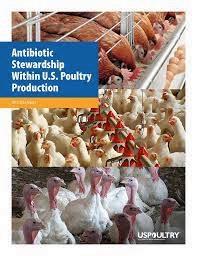A comprehensive survey on the use of antibiotics in broiler production was recently concluded by Dr. Randall Singer of the University of Minnesota. The project was funded through a cooperative agreement with the U.S. Food and Drug Administration and USPOULTRY as contributors.

According to a USPOULTRY release, the following changes in use patterns were documented: -
- Post-hatch administration of antibiotics has declined from a 90 percent administration rate in 2013 to complete elimination in 2021.
- Administration of antibiotics in feed has been almost eliminated. There was no reported use of tetracycline in feed from 2020 onwards and the inclusion of virginiamycin was 97 percent lower as compared to 2013.
- Water-soluble antibiotic use was substantially lower over the survey period. Administration of penicillin declined by 75 percent from 2015; lincomycin by 82 percent; tetracycline by 92 percent and sulfonamides by 98 percent.
 It is estimated that close to half of U.S. broilers are raised antibiotic-free.
It is estimated that close to half of U.S. broilers are raised antibiotic-free.
The report did not specify the average use of antibiotic compounds per unit weight of live chicken produced as in reports from the U.K. that specify grams of drug per kg live mass. Based on the figures derived from the survey, it is evident that antibiotic use is currently at exceptionally low levels.
It is significant to note that average flock mortality and downgrades on an annual basis have not materially increased as a result of reduced use of antibiotics, contrary to the dire predictions preceding the FDA final rules withdrawing some drugs and requiring veterinary feed directives and prescriptions. It is evident that education based on scientific evaluation, the inherent professionalism of poultry health professionals have contributed to the decline in antibiotic use and hence the potential for residues and drug resistance.
From the perspective of public health, it would be beneficial for the medical profession to exercise the same restraint in the use of antibiotics in human medicine as adopted for livestock and poultry production.